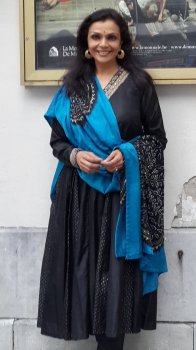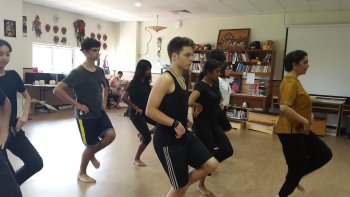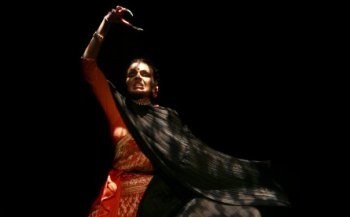
|   |

|   |
March 1, 2015  "Everything is Art Everything is Politics" Chinese artist Ai Wei Wei held in house arrest in Beijing. I discuss two divas in this month's edition - Martha Graham and Chandralekha. Both modernists, passionate about the geographies they inhabited and the urgent need to express through the body. Both women had a profound impact on the course of modern dance in their countries and both were iconic in appearance and attitude. The first was a catalyst for thousands of my generation and beyond. An early modernist who literally invented the grand, high drama intensity of dance theatre (before the term was actually coined) for the early 20th century American dance stage, Martha Graham fueled her particular brand of personal fire into several unforgettable collaborations with painters, composers, designers and writers. A week long homage to her genius was mounted at New York's Joyce Theatre last month, marking the 96th season of the Martha Graham Dance Company. Among the highlights of the matinee show I attended was the iconic LAMENTATIONS. It was, simply, a shot heard throughout the dance world when it premiered as early as 1930. The work was a cathartic release for many generations who had lost husbands and sons in the two world wars, for many who had witnessed death through illness and accidents, and for those who had simply forgotten to cry. The grey tube costume became a famous image and synonymous with the raw energy and passion that was to become the Graham signature. "A tragedy that obsesses the body" is how she describes this memorable short dance. This was the very first time I had seen this work live. Countless videos, several generations of Graham dancers have interpreted this work but to hear Graham and to watch her in LAMENTATION is to watch a true American original. I attended the performance with dancers Sonali Skandan and Kiran Rajagopalan. We chatted after the show over warm apple cider and salad and shared our favourite moments. Each of us were moved by different sections. The level of technical virtuosity, the apparent connections between classical ballet and jazz training and the undulating torso that carried the vivid intensity of her choreographic vision were all at play. Kiran Rajagopalan reminded me of the inspiration LAMENTATION had on pop superstar Beyonce's video of her hit song GHOST. To say I left the Martha Graham dance performance with my heart full would be putting it mildly. I was in tears after LAMENTATION and breathless after ERRAND INTO THE MAZE. The hall was filled with people of all ages but noticeably those over 65 - loyal fans of the Graham style and her impact on American modern dance. Never was the choreography upstaged by athletic prowess. The superb company with dancers from China, Taiwan, Japan and the USA were wonderful interpreters of the historic choreographies. The stunning sets by Isamu Noguchi revealed how Graham envisioned her sets and costumes (Calvin Klein, Halston and Donna Karan) as extensions of her dance genius. Graham's final unfinished work was titled EYES OF THE GODDESS in 1991. She was 96. She passed away the same year. India's Chandralekha was a force of nature for modernity in Indian dance and feminist ideas of the body. There has been much written about her work and her impact on today’s generation of dancers, especially the use of kalaripayattu as training methodology for the body. I watched a marvelous interview conducted decades ago by Sunil Sethi for NDTV. Dressed in her favourite colours and wearing elements of traditional jewellery, Chandralekha's use of words like "cheapie" in connection with the traditional Bharatanatyam costume fabric and references to the Goddess 'Apeetakuchalamba’ (the one from whose breasts nobody has drunk) replete with the traditional "alapadma" hasta were particularly significant since she is widely mistaken for someone who despised tradition and classical dance. Her love of iconography and classical imagery from the sculptures continues to be the central motif for her loyal chronicler Sadanand Menon. In discourses around the world, he recalls the metaphor of the dancing Siva Nataraja and the forgotten 'apasmara' dwarf lying beneath the God's feet as images that inspired her choreography of RAGA. My favourite story of RAGA continues to be when two dance divas watched the performance at the Music Academy open mouthed and then promptly rushed next door to another auditorium where the Bhagavad Gita was being discussed. Feverishly holding onto their prayer beads, they were heard chanting "RAM RAM"! Later one dancer confessed to feeling "unclean" while watching the two male 'kalari' martial artistes perform a slow motion version of the traditional 'kalari massage' on one another in RAGA. Chandralekha may have made the dance practice sari, created by Rukmini Devi Arundale for the Kalakshetra students, in vogue for the stage, but the fully ornate costume - gold, silk, jewels - continues to be a magnet for many young women. "It was the costume that first drew me to Bharatanatyam," confesses dancer/teacher Sonali Skandan. A late entrant into the classical world after her experiences in contemporary dance, this thoughtful woman shared the challenges facing someone who is not South Indian, teaching and performing Bharatanatyam and living in New York City. Being a teacher while developing her own personal voice as a performer is a dilemma she is currently grappling with as are many in the USA who seek to teach and inspire while trying to learn and be inspired by others. February pitched me directly into the bitter winter of New York and the miserable cold of sub zero weather. Bundled into layers, I staggered into the classrooms in Wesleyan University where Professor Hari Krishnan watched over my teaching undergraduate students aspects of 'abhinaya'. I had brought examples of my works to share and discuss but after meeting the classes, I decided to work with classic love ballads from the pop anthology as immediate reference points. Country singer Shania Twain's classic "You're still the one" was my song of choice and I put them through the various rhythms, foot beats (tatti mettu) and gesture language that expressed the words. "You're still the one I run to Still the one I belong to You're still the one I want for life You're still the one that I love You're still the one I dream of You're still the one I kiss good night." Needless to say, the kids were thrilled to be able to relate to English words and put them to Indian accents. We can find 'rasa' and 'abhinaya' in many places. Like the emotionally charged rendition of GLORY, the theme song from the film SELMA at the Oscar awards ceremony. Performed by John Legend and rapper Common, it brought tears to many eyes in the audience and at home watching. (My eyes filled up, I confess) Common’s use of gestures and body language in defiance towards racial injustice suggested 'veera rasa' and soaring chorus was 'karuna rasa' at its height. The Academy awards were the talk of the town. Literally, taxi drivers, Starbucks barista makers and sales clerks were discussing the films, the fashion and the actors they were rooting for. How wonderful to have artistic achievement become centre stage in everybody's life. It was front page news on all media and endless discussions about race, gender inequity and the famous hashtag #askhermore. Highlighted by award winning actress Julianne Moore, it focused on the media's superficial obsession with looks, form and dress that plagues many serious actresses. We too need to use this hashtag for Indian dance. We need to look beyond costume and gloss. There is much, much more to ask and to question. #askhermore or #lookformore, or #demandmore or how about #nothingbutexcellence. February was the month of the magical night of Sivaratri. This annual alignment of the stars and the planets brings a super charged aura onto the planet. And one of the most spectacular all night events is at the ISHA CENTRE in Coimbatore, Tamilnadu. I have been fortunate to have witnessed many a magical night of performances and moving dance installations at the magnificent campus founded and led by spiritual leader Sadguru Jaggi Vasudev. What stands out in my mind is the breathtaking performances by the students carrying large fire torches and moving in a choreographed unison to drums, gongs and chanting. The power of Siva's energy was made larger, more expansive and thus, universal. Sivaratri is also the occasion for the annual regurgitation of the Natyanjali festivals. In the guise of "natya aradhana" for Siva, several organizations now demand money from the unsuspecting NRIs flying from Singapore, Sri Lanka and Malaysia who come in large numbers to "offer their dance as worship". Lakhs of rupees are spent for this "divine tour". More opportunities for extractions are being created by "agents" who are arranging shows for these visiting dancers. The tag line is "Your chance to show your divinity before Siva!" "Surrender your art at Siva's feet!" If only it could be made clear and professional. Fees charged for coordination, booking, accommodation, etc. It would actually become a lucrative area rather than this shadowy activity of pretense and subterfuge. The cultural phenomenon sweeping the world is the film version of the disappointing book FIFTY SHADES OF GREY. It needs discussion since it engages with the provocative idea of sex, submission, domination and control. The film which is the highest grossing opening weekend in the history of cinema revealed how obsessive most women are about their private fantasies. Compare the dark, patriarchal palette of the film to the sweet and sentimental padams, kritis and javalis of the classical music canon. O Radha When the fresh buds of the Tamala flower Emit the aroma that fills the air like the scent of deer musk Manmatha's nails tears at the heart of young people Hari dances with the young women during this time of love. One young gopi with heavy breasts embraces Hari Another looks longingly at the lotus face of Madhusudhana A girl with shapely hips plants a kiss upon him In the guise of whispering a secret In this erotic dance, He hugs someone, kisses another while glancing smilingly at another and follows yet another (a free translation from Jayadeva's Geet Govinda- 12th century) How gentle and lush these moodscapes are How much the imagination is coaxed into vistas of beauty Nature and nurture flow into one another and the most erotic can be suggested rather than "horse whipped" into pain, tears and humiliation! FIFTY SHADES OF GREY was a disturbing film but I watched it alone without my friends, all of whom had seen it and claimed to be universally 'disgusted'! Yet it was the topic over a 3 hour lunch! The week that I was in the US coincided with the 43rd anniversary of the iconic films LOVE STORY from where the immortal lines emerged. "LOVE MEANS NEVER HAVING TO SAY YOU ARE SORRY." I may not agree with that comment but more was conveyed through the eyes of Ali McGraw and Ryan O’ Neal than the lip biting and eyes rolling of ingénue actress Dakota Johnson in FIFTY SHADES. Grey was always the nature of life and art. The inbetween-ness of absolutes. The interstices that occupy the larger part of politics, art and life. Do we need to find another colour to express the ambiguity and vulnerability of creative endeavour. That shade is tainted by cruelty and wanton humiliation of women. It is the time for the annual budget in India. With endless challenges, the issue that excites Indians seems to be lower price of GOLD! Business awaits lower taxes and more incentives. Textiles await more support for artisans ending their lives in desperation. Performing artistes wait patiently for clarity on what direction the Culture Ministry will adopt. There is the oft quoted and now tired phrase "India is a great civilization that has taught the world much about culture, science, medicine. It is time to regain this glory through our arts and artistes". Blah Blah Blah.. and the speeches go on and on. The most apt hashtag for this attitude is #stillwaiting. Like pining 'nayikas' draped over doorways with a wistful look on their faces, performing artistes await a coherent framework for more vigorous and meaningful engagement in the cultural fabric of India. From the constitution of the various cultural committees to the allocation of resources to various states and a more energetic pursuit of the public-private partnerships with businesses, there is so much that is possible as long as red tapism and cronyism does not step in. In discussion with a curator from Ethiopia, I was reminded of an important attitude. DO NOT GIVE UP ON THE GOVERNMENT. There may be endless potholes but we must continue to find ways to navigate the terrain. A wistful Facebook post by theatre director Rajendra K Srinivasan of NSD, New Delhi suggests that since actors and performers do not constitute a notable voting bloc, that perhaps artistes will continue to be ignored by politicians. #remainhopeful  The month ended with my one day session with international students at the American International School in Chennai. Populated by foreign nationals and many Indian kids born out of India, I seemed to land on another planet 20 minutes from home. From the food in the cafeteria to the American twang in multiple voices, it was a day of creative movement for dance students. Bright minds, many lacking concentration and forever chattering, their minds filled with noise and bludgeoned with an overload of images and information. Still, the spanking new auditorium equipped with 250 lights, a dance floor and all sorts of gadgets is the envy of the city. The security within the campus is so tight that I felt like I was taking a flight with the endless rounds of x-rays that my handbags and dance paraphernalia was subjected to. #ufffyuma DANCE was never centre stage in the history of the world but for the months of February and March CRICKET is. I could not go anywhere without hearing about what match was on and what just concluded. In the wintry cold of New York City, desi Wall Street billionaires congregated to watch the all night India-Pakistan one day International World Cup match cheering and booing like college kids. All these achievers had young daughters who were dance students and all of them had planned Ivy League education where dance would be left far behind. And NO. None of them support or attend dance shows in NYC. And THAT is the reality. So then WHY do young women learn dance? To perform? To collect a photo and video album for social media? To show off to their friends? To glam up with all the paraphernalia for about 10 to 12 years and then what??? Once these young women stop dancing they don’t even morph into good rasikas. They don’t support or attend dance performances or convince their corporate friends to join them. So then what is the purpose of the endless workshops and teaching that panders to short term vanity? What do gurus and mentors hope to achieve five or ten years from now? There is yet to be a recognition in India for dance as a professional activity. Even the best of us do not touch the economic horizons that dictate SUCCESS... and today's Indians are notorious for not respecting the ephemeral. What cannot be felt and touched and bought and owned cannot amount to much!!!  A MILLION SITAs
I have been asked during my travels about why I sound sour or angry in my monthly editorials. I am IMPATIENT about the immense possibilities that are not enhanced, VEXED about the depletion of the cultural eco systems and IRRITATED about mediocrity being lauded. Some of my dance friends who live and work outside India confess, "it is through the teaching that we have fallen in love with classical dance all over again!". I too, enjoy teaching in short spurts when I travel but do not regret for a single moment my decision to not start a teaching institution in Chennai when I returned from New York 25 years ago! I return to a remount of my earlier work, A MILLION SITAs. Premiered in 2010 to much appreciation in Chennai and Bangalore, this new version incorporates storytelling as a theatrical device as well as newer commentaries on the best loved characters in India's mythological fabric. Drawing from my favourite women in the timeless story - Ahalya, Surpanakha, Manthara, Mandodari and Sabari, Sita's shadow continues to enchant and provoke us across centuries. Performances in Kolkata, Malaysia and later New York City will bring her voice to diverse audiences. Observing my own responses to the familiar story as well as my body adapting to passing time is like keeping a personal diary. Maybe one day I can share these impressions. We record the passing of beloved Carnatic musician and teacher Mrs. Suguna Purushotaman age 74. She was a brilliant artiste who dedicated her life to grooming many a fine performer. Meanwhile tributes continue for Mandolin Srinivas whose tragic end shocked musicians around the world. He would have been 46 on February 28th. It is HOLI.. Colours, melting snow, and a time to fall in love all over again... Round.. like a circle in a spiral Like a wheel within a wheel Never ending or beginning Like an ever spinning wheel LIFE CONTINUES ITS ENDLESS DANCE Dr. Anita R Ratnam Chennai/ Kolkatta PS. Goodbye to my favourite Vulcan. R I P Spock! Leonard Nimoy this Trekkie will miss you! Twitter: @aratnam Facebook: Anita R Ratnam Instagram: @anitaratnam Blog: THE A LIST / anita-ratnam.blogspot.in |